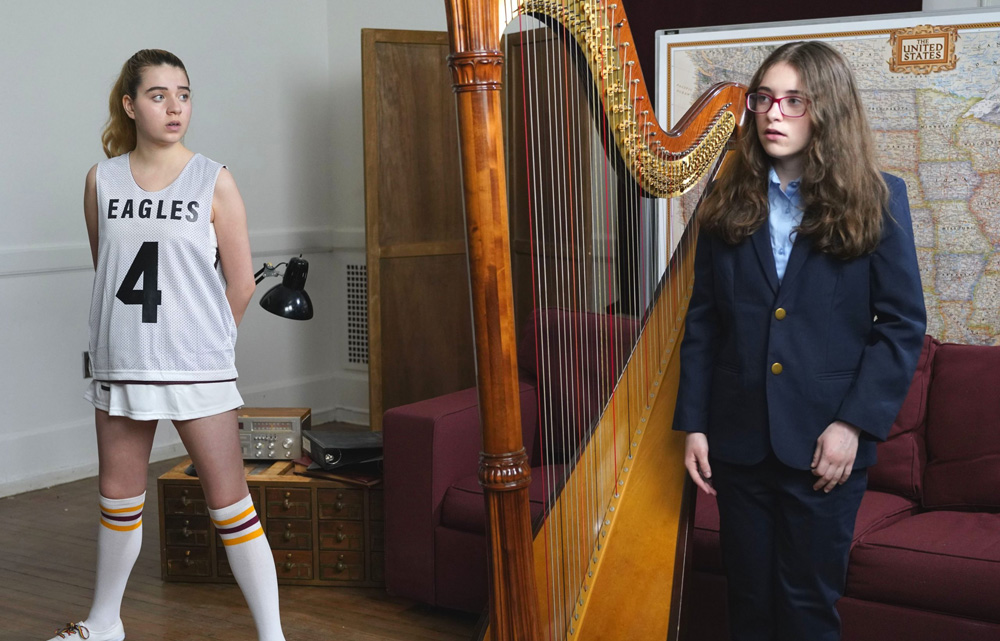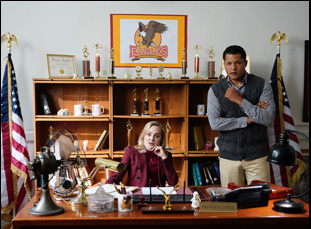“Are you ready?” Meg (Alyssa Emily Marvin) asks her classmate Penny (Zoe Wilson) in the hallway at Lincoln High School in “Run Amok,” shortly before it becomes clear that nobody is in Nitzan Mager’s darkly amusing short. The two aren’t in trouble before entering the principal’s office, but they could be depending on what Meg plans to pitch at the invitation of her drama teacher (Brandon J. Dirden) to commemorate the 10th anniversary of a tragic shooting at the school and Penny is just worried about getting her lines right, more comfortable on the basketball court than on the stage. If Principal Linda (Geneva Carr) can reasonably expect something solemn from Meg, dressed professionally well beyond her years, all buttoned up in a blue blazer, and hauling in a harp to play, she has another thing coming as Meg starts strumming the opening hook for Black Sabbath’s “Iron Man,” subbing in her own lyrics.
Although the principal is quick to stop Meg from continuing once she starts to get an idea of what she’s up to, but not before the student who has a very personal tie to the tragedy can do her rendition of Pat Benatar’s “Hit Me With Your Best Shot,” “Run Amok” presents a different kind of standstill. Reflecting the paralyzing position that everyone is put in during the aftermath of such a traumatic event, Mager cleverly captures the desire of both the school faculty that wants to be encouraging of the young minds they’re charged with educating and still concerned that left to their own devices, they may end up frustrating themselves or worse without the proper vocabulary to properly express their grief. Although it’s clear Meg can hit all the right notes on her harp, there is something a bit off-key about the music she’s playing for the show, cover songs that may have personal lyrics yet still need some ironic distance in order to be played in the first place.
Between the pained expressions of Carr and Dirden as the adults bewildered by Meg’s compositions, rendered as inexperienced as the kids when it comes to a situation like this, and Marvin’s confident performance as the student who is quick to turn the lessons she’s been taught about artistic expression to better understand the past against them, “Run Amok” gets at catharsis that its characters try to reach for comedically and has become a surprising crowdpleaser on the festival circuit since its premiere earlier this year at the Cleveland Film Festival, earning a Grand Jury Prize at IFF Boston for Best Narrative Short and now in contention for an Oscar. After the film recently made its online debut as a Vimeo Short of the Week, Mager spoke about the origins of the provocative comedy, how the harp made its way into the frame and looking at the bigger picture, both as far as the film itself and the conversations it’s started to spark.
I really wanted to tell a story that touched on this very challenging subject of gun violence and I felt that there have been films, both documentaries and narratives, that deal with the issue, specifically in schools. But I felt that they’d all come from a place of processing tragedy through the immediate lens of the event and also through the lens of drama, understandably so because it is such a horrific thing that happens. But I felt that was paralyzing for me as a storyteller, and in a bigger picture sense, the fact that we’re constantly confronted with headlines about things like this happening, it almost feels like we were in this lull of normalcy [where] these things happen and it’s tragic, but there’s a sense of inevitability about it that felt frustrating to me. So I really wanted to take an unconventional and perhaps slightly shocking approach to it and really use the language of comedy to just shift the perspective of it and jar the audience a little bit and remind them that this is not normal.
When it’s the story of a teenage girl processing trauma through her art, is there actually research you can do about the process?
I definitely was researching the effect that this has on young people, not only who survive a shooting incident, but [for] whom lockdown drills are a part of their regular life and there’s this constant hum of anxiety of “Could this happen at my school? The art therapy part is more personal to me because I think this film specifically was my way of processing my anxiety and fear around this issue, and most of the things that I make are to process — things that are difficult and challenging personally or in the world.
When a character creates a fictional work of art like this, how much did you flesh that whole idea out? Is there a full musical in your mind?
That process for Meg, the main character, of trying to come up with a play is really the meat of the thing. It’s her trying and failing, and I think there isn’t really ultimately one grand vision for the play that’s created by her or by myself as the writer, because it’s really a series of attempts to try to figure out how to tell the story, so it’s a little bit of a mess.
The harp becomes a big part of this. Was that foundational to the story?
The harp was involved pretty early on. I live in Brooklyn and I had a downstairs neighbor who was a harpist, so I would hear her playing while I was working on the story and then ultimately, it was very fortuitous because it had so many layers of it. First of all, the instrument itself we associate with innocence and angels playing the harp, and [in the story] there’s this sense of the innocence of the children being taken away from them or the children not being taken seriously because they’re just seen as needing to be kept in the dark. Then the case [for the harp] itself was just such a gift because it turns out it looks just like a coffin, so it was one of those happy accidents to have a harp player who lived below me.
It is a striking visual – the harp case dividing Penny, the basketball player, from Meg, who’s in this suit, in this classic classroom. What was it like to find the right aesthetic for this?
We actually shot it in City College up in Harlem and we were working with just a blank white classroom that we took all of the desks and chairs out of. We really built the set from scratch, minus the walls, and I always wanted a very specific style and tone for it to feel a little bit heightened. As people have pointed out, it definitely has a little bit of a nod to Wes Anderson in the specificity of the framing, and definitely for the costumes as well as the set, really thinking in terms of color and having it feel almost theatrical. The short film is actually part of a larger project, a feature film that we’re now working on, and ultimately this play Meg is pitching in the short film is what she also strives and struggles to do in the feature, so theater is an inspiration, visually and [I wanted to] have this theatrical quality for the shots and the costumes of the characters as well.
What was it like to find Alyssa, who strikes that tone just right?
We auditioned maybe 30 girls for the role originally, and from the first time I saw Alyssa’s audition tape, she was just so fantastic. She just really is so smart and so present and so vulnerable and she was just really able to channel this character and bring her to life off the page. It was so wonderful working with her, and of course, since we filmed the short, Alyssa has now been on in two Broadway plays. She’s now with Elle Fanning and Sarah Paulson in “Appropriate.”
Once the film starts taking on a life of its own, were there any directions this took on or qualities it had that you may not have expected, but you could get excited about?
I didn’t really know what to expect was how audiences would react to it, and the audience reactions have been quite varied. Some people have started sobbing when they watch the film, and some people laugh, which is the intent, even if it’s uncomfortable laughter. And then it inspires like this very wide ranging sort of conversation on the issue and on the film itself, so that’s been a really fun piece of it is just seeing how it engages audiences, which is usually quite visceral.
It’s had quite a festival run. What’s it been like to travel with?
It’s been fantastic. I’ve loved being able to go to the festivals and I always like to sit in the very far back row and watch the audience watch the film. Then the Q and As have been just so fascinating. It’s not a neutral film, right? People have strong feelings about it, so it’s been really great to be able to actually in person have that kind of engagement with audiences.
“Run Amok” is now streaming online.





